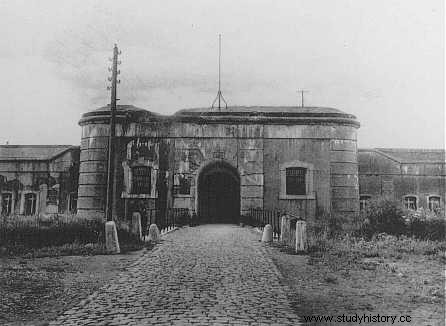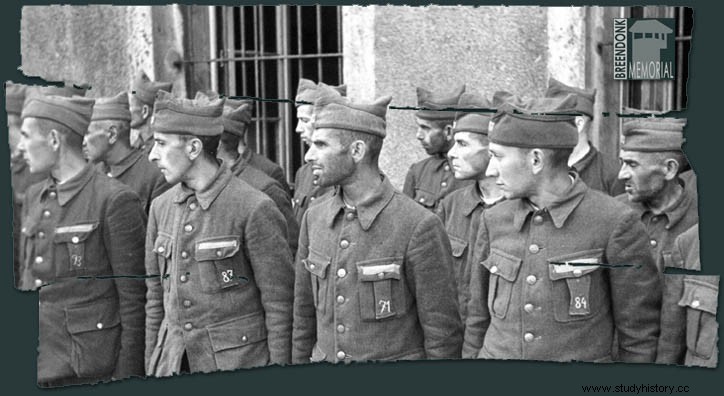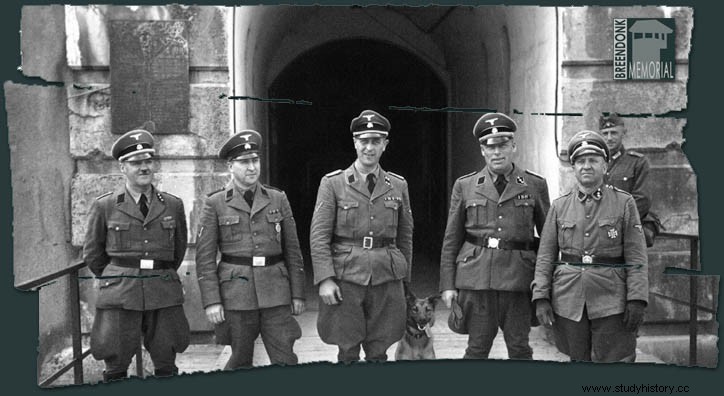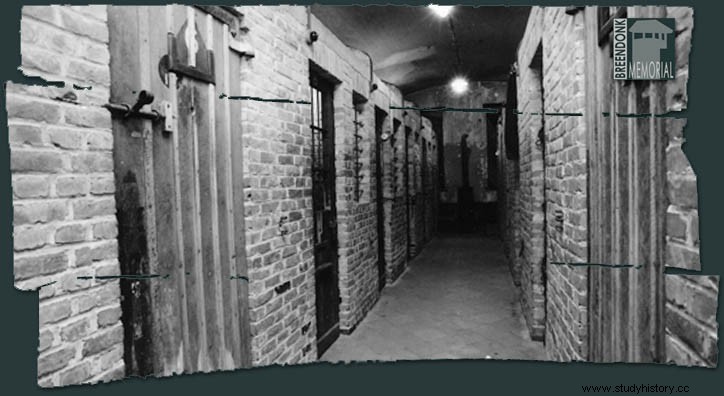The Nazis transformed Fort Breendonk -built in 1906 and located 20 km from Antwerp- in a prison camp. On September 20, 1940, the first prisoners arrived. They were petty criminals, people classified as antisocial and those who did not abide by the new laws imposed. Later they were Resistance fighters and political prisoners. Another section of the camp was used as a transit point for Jews who were to be sent to die in other camps, primarily Auschwitz. The camp was guarded by about 20 German SS members supported by 33 Wehrmacht soldiers.

Breen Field Entrance
Upon arrival at the camp and shouting Heil Hitler , the new prisoners were taken to the patios, where they had to stand facing the wall until they were processed. In the SS office the prisoners were registered in the concentration camp, passing from being citizens to a simple number. Once registered, they were taken to the tailor's to exchange their civilian clothes for an old Belgian army uniform. When the supply of soldier boots ran out, inmates were allowed to wear the civilian shoes they arrived in the camp with. The uniforms of the deceased were reused until they gave out, riddled with holes and stained with blood.

Breendonk Prisoners
The Jews were separated from the rest of the prisoners and confined in a section of the camp specially prepared for them ; the rest were housed in cold, damp stone barracks on triple bunks and straw mattresses shared with the bedbugs. The prisoners were subjected to forced labor for 12 hours a day:they had to remove the thick layer of earth that covered the fort and move it to create a high-rise, circular earthen wall around the fort and hide it from prying eyes. The food they received… in the morning 100 grams of bread and two bowls of infusion of roasted acorns; at noon two plates of watery soup and in the afternoon 125 grams of bread and two bowls of infusion of roasted acorns. The prisoners supplemented that miserable diet with what they could:plant roots, grass, potato skins… even the afterbirth of a sheep. They were only allowed to use the toilet twice a day, all at the same time. They were only allowed 5 minutes, but since none of the prisoners had a clock, most finished within a minute, for fear of exceeding the allotted time and receiving punishment. Failure to make the bed properly was also punished with a day without food.
Death in Breendonk .
In addition to the numerous deaths due to illness or malnutrition -which in the death certificates the German doctors indicated as a cause weakness of heart -, Breendonk was the field in charge of providing the candidates for the «an eye for an eye and a tooth for a tooth «:When members of the resistance killed some German or Belgian collaborator, 10 prisoners were chosen at random to be shot. After the execution, the Jews had to clean the blood from the posts where they had been tied and retrieve the uniforms and boots of the executed.

Firing Posts
There were also other deaths due to beatings by the so-called heads of barracks -prisoners who in exchange for privileges such as better food, medical care and occasional encounters with women, were in charge of monitoring and controlling their companions-. Walter Obler and Valère De Vos It was two of these chiefs who killed several comrades, but they paid for it:Obler, who in addition to killing 10 prisoners made a small capital of money and jewels in exchange for sending the prisoners letters and food from their relatives, was tried and shot in 1947; De Vos, who was transferred along with the rest of the prisoners when he was evacuated from the camp in 1944, died two days after arriving at Buchenwald from the beatings he received from those who had previously suffered his torture. There was also one death from multiple Lump bites. , the German shepherd of camp commander Philippe Schmitt .

In 1942 the torture chamber was inaugurated. In sessions that could last up to 5 hours, the specialists in this type of work applied incandescent irons and electric shocks to the genitals, broke the bones with presses, burned them with cigarettes... a small trench in the ground allowed the evacuation of blood and urine . The doors of the chamber remained open so that the rest of the prisoners could hear the cries and moans.
Testimonials from the field .
Among the almost 4,000 prisoners who passed through the camp between September 1940 and August 1944, there were two of them who gave testimony of those days:León-Ernest Halkin , Professor of History at the University of Liège, and Paul Lévy , engineer and professor at the Catholic University of Louvain and at the University of Strasbourg. Halkin will write the play In the shadow of death in 1945, where he recounts his experience at Breendonk. On February 17, 1941, the first victim since the opening of the Breendonk camp died in one of the isolation cells:Julius Nathan . Lévy, in his work The Challenge , describes how it happened:Nathan couldn't keep up with the pace of work and collapsed onto the wheelbarrow; the SS took him to an isolation cell and old Nathan, asthmatic and alone, died that same night.

Isolation cells
Fort Breendonk it was declared a national memorial in 1947, recognizing the suffering and cruelty suffered by the prisoners. Fort Breendonk is open to visitors and Buendía Tours , a company that organizes guided tours in Belgium with guides in Spanish, has prepared a tour of the Breendonk concentration camp. In this document You have all the information about the tour (schedules, dates, prices...).

